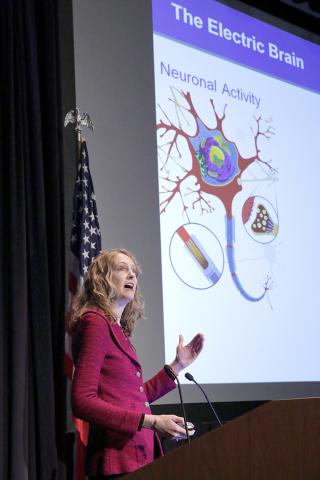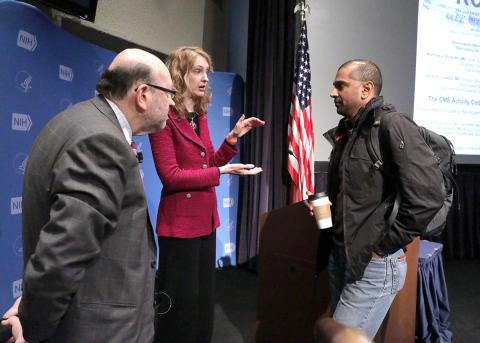‘Rome to Rockville Pike’
Stimulating the Brain from Without: Therapy and Science

Photo: Ernie Branson
Renowned television host Dick Cavett once had this to say about electronic convulsive therapy (ECT), which he underwent for depression: “In my case, ECT was miraculous. It was like a magic wand.”
It is shock therapy’s stubborn efficacy that has kept it alive, despite the alarming image it typically conjures.
The procedure began in Rome in 1938, when Drs. Ugo Cerletti and Lucio Bini induced seizures in patients by shocking them with electricity. Two years later, at an American Psychiatric Association meeting in Cincinnati, shock therapy made its U.S. debut, said NIMH’s Dr. Matthew Rudorfer. He was one of two speakers from that institute who walked a Lipsett Amphitheater Grands Rounds audience through the history and future prospects of “non-invasive neuromodulation” on Mar. 15.
Over the years, ECT has come in and out of fashion, said Rudorfer, who came to NIH in 1985 and has been involved in protocols employing ECT in Clinical Center patients with depression, and more recently has worked with NIMH grantees around the country seeking to optimize the intervention. True, in its early days, shock therapy fractured bones and broke teeth, but it has also offered relief in the most intractable cases of depression. Its adherents, including Kitty Dukakis, wife of former presidential hopeful Michael Dukakis, swear by its efficacy. The ECT of the moment is kinder and gentler than its brutal predecessor.
The notion that causing a seizure might be helpful in patients with mental problems began not with electricity, but with camphor oil, Rudorfer explained. In 1934, Hungarian physician Ladislas Meduna induced an epileptic seizure in a 33-year-old man with catatonic schizophrenia who had been suffering for 4 years in that state. After 5 injections of camphor, the patient came to in his right mind and asked how long he had been hospitalized. When told, he was incredulous.
This speaks to two of convulsive therapy’s enduring virtues—rapidity of response and efficacy, Rudorfer noted. Given that depression is the largest cause of disability worldwide, and increased by 18 percent in the years 2005-2015, shock therapy is not yet ready for retirement.
Multiple studies pitting ECT versus anti-depressant medications over the years have shown that ECT has the upper hand in cases of severe depression, acute psychosis and some cases of schizophrenia, said Rudorfer. “We have a lot of options today, but still not enough.”

Photo: Ernie Branson
These days, ECT is administered to a sleeping, anesthetized patient pre-treated with muscle relaxants. There is no thrashing about, small currents are applied in ultra-brief pulses, and electrode placement is more judicious—putting both leads on the right side of the scalp has proven more beneficial than the original scheme of attaching electrodes on both sides. Patients wake up less confused, have fewer memory problems and tend to do well.
However, “Even when it works well, ECT doesn’t prevent relapse,” said Rudorfer. One study showed that, over 6 months, 84 percent of ECT patients relapse when the therapy is not accompanied by some kind of antidepressant drug.
A recent NIMH cooperative agreement study dubbed Prolonging Remission in Depressed Elderly (PRIDE), conducted at 12 sites and enrolling 240 acutely depressed patients, demonstrated an impressive remission rate greater than 60 percent. Among those whose depression had remitted, patients who received a personalized schedule of maintenance ECT sessions in addition to medication (an antidepressant plus lithium) exhibited “a significantly lower incidence of relapse,” Rudorfer said, compared to those randomized to maintenance medications only.
It is still not clear how ECT works, but it is thought to involve dopaminergic circuits in the brain, he said. “Brain imaging and circuitry studies are ongoing.”
Rudorfer said ECT is still not universally available in the U.S. “There is still lots of prejudice and stigma, and there are legislative restrictions in some states.” He anticipates further minimization of cognitive adverse effects in ECT and the development of more focal, localized brain stimulation techniques.
The second speaker, Dr. Sarah Lisanby, director of NIMH’s Division of Translational Research and director of the noninvasive neuromodulation unit in the Experimental Therapeutics and Pathophysiology Branch, dialed the voltage down dramatically. Her specialty is brain stimulation technologies including transcranial magnetic stimulation (TMS), a therapy born abroad in 1985 but pioneered in this country at the Clinical Center. She said TMS has been transformative as a tool to test causal relationships between brain and behavior and to measure and modulate plasticity in the brain.
The normal human brain generates a weak electric field as it goes about its business. TMS induces small currents in the brain and is considerably more “non-invasive” than ECT (although its cousin, magnetic seizure therapy, or MST, induces focal seizures that, like ECT, exert an anti-depressive effect). TMS induces weak fields on the surface of the cortex and stimulates selected brain circuitry.
Lisanby and her colleagues are exploiting the targeted use of TMS to measure plasticity, or the ability of the brain to change before and after treatment.

Photo: Ernie Branson
“We can modulate plasticity in a lasting way, with therapeutic value,” she said, “either as a stand-alone treatment or in combination with other modalities.”
Cortical reactivity can be measured with standard tools such as EEG and EMG, which have helped establish that deficient plasticity is a hallmark of schizophrenia and depression. Anything that can stimulate plasticity—such as repetitive TMS (rTMS)—can potentially remediate disease.
Lisanby said that 1.5 months of daily rTMS has been shown to exert a significant anti-depressant effect in depressed patients.
In 2008, the first TMS devices were cleared by the FDA. They normally induce no seizures in patients, have a remission rate of only 15-30 percent (three times less effective than ECT), have no known risk of memory loss and only a small risk of seizure, dependent on the dose.
“ECT is already highly effective, but we need to improve its neurocognitive safety,” said Lisanby. “In the case of TMS, it’s already very safe, but we need to enhance its efficacy.” Her vision of next-gen neuro-mod includes optimized, personalized TMS with improved precision in the spatial, temporal and contextual aspects of dosing.
At her most optimistic, she believes that sculpting of brain plasticity for therapeutic ends may be possible. One way to target the plastic changes is to engage the brain in a specific action while it is being stimulated, to target the effects of the stimulation to specific task-related networks. Lisanby has used this approach to improve working memory by having subjects perform a working memory task while receiving stimulation.
“We acknowledge that the brain is much smarter than we are,” she concluded.
“This is an exciting time…New tools are helping us discover more than we ever could a few decades ago. I think we can teach the old dog of ECT some new tricks.”
